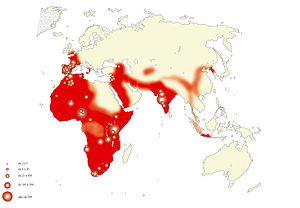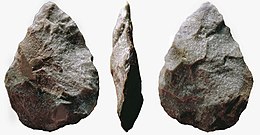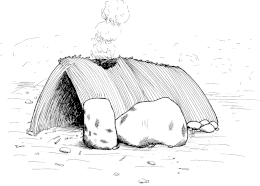
Back Acheuleen Afrikaans أشولينية Arabic Aşel mədəniyyəti Azerbaijani Sevenadur Acheulean Breton Acheulià Catalan Acheuléen Czech Acheuléenkulturen Danish Acheuléen German Αχελαία Περίοδος Greek Aŝela kulturo Esperanto
 Map of the distribution of Middle Pleistocene (Acheulean) cleaver finds | |
| Geographical range | Africa, Europe, and Asia |
|---|---|
| Period | Lower Paleolithic |
| Dates | 1.95–0.13 Mya |
| Type site | Saint-Acheul (Amiens) |
| Preceded by | Oldowan |
| Followed by | Mousterian, Clactonian, Micoquien, Aterian, Soanian, Sangoan, Acheulo-Yabrudian complex, Fauresmith industry |



Acheulean (/əˈʃuːliən/; also Acheulian and Mode II), from the French acheuléen after the type site of Saint-Acheul, is an archaeological industry of stone tool manufacture characterized by the distinctive oval and pear-shaped "hand axes" associated with Homo erectus and derived species such as Homo heidelbergensis.
Acheulean tools were produced during the Lower Palaeolithic era across Africa and much of West Asia, South Asia, East Asia and Europe, and are typically found with Homo erectus remains. It is thought that Acheulean technologies first developed about 2 million years ago, derived from the more primitive Oldowan technology associated with Homo habilis.[2] The Acheulean includes at least the early part of the Middle Paleolithic. Its end is not well defined, depending on whether Sangoan (also known as "Epi-Acheulean") is included, it may be taken to last until as late as 130,000 years ago. In Europe and Western Asia, early Neanderthals adopted Acheulean technology, transitioning to Mousterian by about 160,000 years ago.
- ^ Musée de Préhistoire Terra Amata. "Le site acheuléen de Terra Amata" [The Acheulean site of Terra Amata]. Musée de Préhistoire Terra Amata (in French). Retrieved 10 June 2022.
- ^ Margherita Mussi; et al. (Oct 12, 2023). "Early Homo erectus lived at high altitudes and produced both Oldowan and Acheulean tools". Science. 382 (6671): 713–718. Bibcode:2023Sci...382..713M. doi:10.1126/science.add9115. PMID 37824630. S2CID 263971011.
© MMXXIII Rich X Search. We shall prevail. All rights reserved. Rich X Search